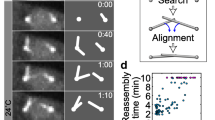Abstract
The basis for stable versus unstable kinetochore orientation was investigated by a correlated living-cell/ultrastructural study of grasshopper spermatocytes. Mal-oriented bivalents having both kinetochores oriented to one spindle pole were induced by micromanipulation. Such malorientations are stable while the bivalent is subject to tension applied by micromanipulation but unstable after tension is released. Unstable bivalents always reorient with movement of one kinetochore toward the opposite pole. Microtubules associated with stably oriented bivalents, whether they are mal-oriented or in normal bipolar orientation, are arranged in orderly parallel bundles running from each kinetochore toward the pole. Similar orderly kinetochore microtubule arrangements characterize mal-oriented bivalents fixed just after release of tension. A significantly different microtubule arrangement is found only some time after tension release, when kinetochore movement is evident. The microtubules of a reorienting kinetochore always include a small number of microtubules running toward the pole toward which the kinetochore was moving at the time of fixation. All other microtubules associated with such a moving kinetochore appear to have lost their anchorage to the original pole and to be dragged passively as the kinetochore proceeds to the other pole. Thus, the stable anchorage of kinetochore microtubules to the spindle is associated with tension force and unstable anchorage with the absence of tension. The effect of tension is readily explained if force production and anchorage are both produced by mitotic motors, which link microtubules to the spindle as they generate tension forces.
Similar content being viewed by others
References
Ault JG (1984) Unipolar orientation stability of the sex univalent in the grasshopper (Melanoplus sanguinipes). Chromosoma 89:201–205
Ault JG (1986) Stable versus unstable orientations of sex chromosomes in two grasshopper species. Chromosoma 93:298–304
Church K, Lin HP (1985) Kinetochore microtubules and chromosome movement during prometaphase in Drosophila melanogaster spermatocytes studied in life and with the electron microscope. Chromosoma 92:273–282
Gorbsky GJ, Sammak PJ, Borisy GG (1987) Chromosomes move poleward in anaphase along stationary microtubules that coordinately disassemble from their kinetochore ends. J Cell Biol 104:9–18
Henderson SA, Koch CA (1970) Co-orientation stability by physical tension: a demonstration with experimentally interlocked bivalents. Chromosoma 29:207–216
Mitchison TJ, Kirschner MW (1985) Properties of the kinetochore in vitro. II. Microtubule capture and ATP-dependent translocation. J Cell Biol 101:766–777
Nicklas RB (1967) Chromosome micromanipulation. II. Induced reorientation and the experimental control of segregation in meiosis. Chromosoma 21:17–50
Nicklas RB (1983) Measurements of the force produced by the mitotic spindle in anaphase. J Cell Biol 97:542–548
Nicklas RB, Koch CA (1969) Chromosome micromanipulation. III. Spindle fiber tension and the reorientation of mal-oriented chromosomes. J Cell Biol 43:40–50
Nicklas RB, Kubai DF (1985) Microtubules, chromosome movement, and reorientation after chromosomes are detached from the spindle by micromanipulation. Chromosoma 92:313–324
Nicklas RB, Staehly CA (1967) Chromosome micromanipulation. I. The mechanics of chromosome attachment to the spindle. Chromosoma 21:1–16
Nicklas RB, Brinkley BR, Pepper DA, Kubai DF, Rickards GK (1979) Electron microscopy of spermatocytes previously studied in life: methods and some observations on micromanipulated chromosomes. J Cell Sci 35:87–104
Nicklas RB, Kubai DF, Hays TS (1982) Spindle microtubules and their mechanical associations after micromanipulation in anaphase. J Cell Biol 95:91–104
Östergren G (1951) The mechanism of co-orientation in bivalents and multivalents. Hereditas 37:85–156
Steffen W (1986) Relationship between the arrangement of microtubules and chromosome behaviour of syntelic autosomal univalents during prometaphase in crane fly spermatocytes. Chromosoma 94:412–418
Author information
Authors and Affiliations
Rights and permissions
About this article
Cite this article
Ault, J.G., Nicklas, R.B. Tension, microtubule rearrangements, and the proper distribution of chromosomes in mitosis. Chromosoma 98, 33–39 (1989). https://doi.org/10.1007/BF00293332
Received:
Issue Date:
DOI: https://doi.org/10.1007/BF00293332




